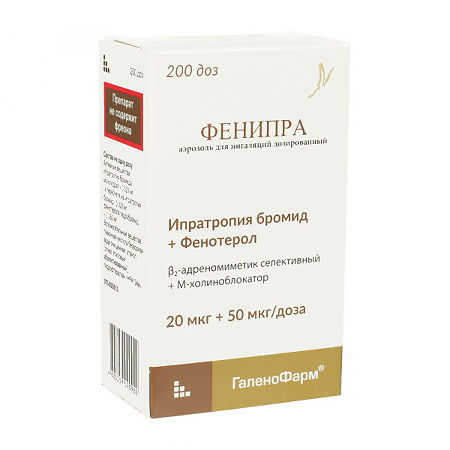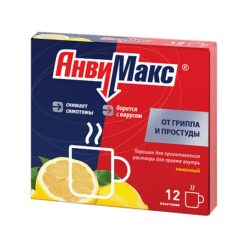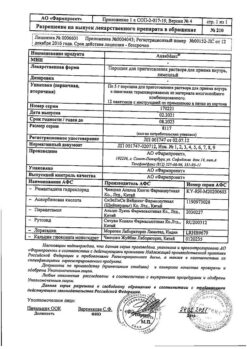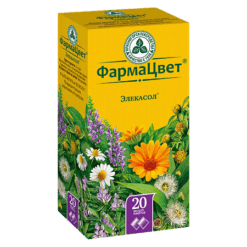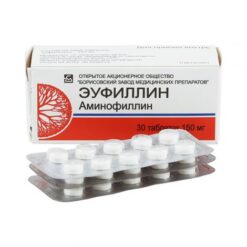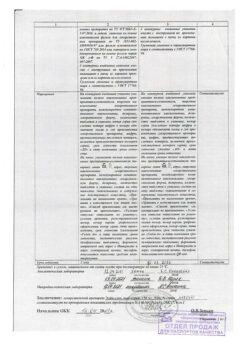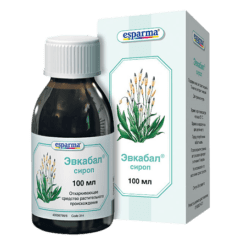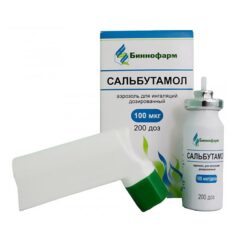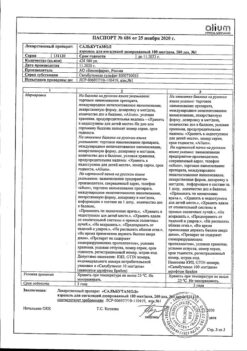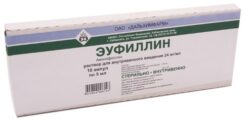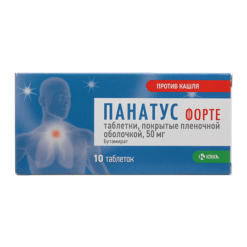No products in the cart.
Phenipra aerosol 20 mcg/dose+50 mcg/dose 200 doses
€1.00
Out of stock
(E-mail when Stock is available)
Description
Phenipra contains two components with bronchodilator activity: ipratropium bromide, an m-cholinoblocker, and fenoterol, a b-adrenomimetic. Bronchodilation during inhalation administration of ipratropium bromide is mainly due to local rather than systemic anticholinergic action. In patients with bronchospasm associated with chronic obstructive pulmonary diseases (chronic bronchitis and pulmonary emphysema) a significant improvement in lung function (increase O PV1 and PSV by 15% or more) was noted within 15 min, the maximum effect was reached after 1-2 h and lasted in most patients up to 6 h after the injection. Ipratropium bromide is a quaternary ammonium derivative with anticholinergic (parasympatholytic) properties. Ipratropium bromide inhibits vagus nerve reflexes. Anticholinergic agents prevent increased intracellular concentration of calcium ions, which occurs as a consequence of interaction of acetylcholine with muscarinic receptors of bronchial smooth muscles. The release of calcium ions is mediated by a system of secondary mediators, which include inositol triphosphate and diacylglycerol.
Ipratropium bromide has no adverse effect on airway mucus secretion, mucociliary clearance, and gas exchange.
Phenoterol selectively stimulates b 2 -adrenoreceptors at therapeutic dose. Stimulation of b 1 -adrenoreceptors occurs at high doses.
Fenoterol relaxes the smooth muscles of the bronchi and blood vessels and counteracts the development of bronchospastic reactions caused by histamine, methacholine, cold air and allergens (immediate-type hypersensitivity reactions). Immediately after administration, fenoterol blocks the release of mediators of inflammation and bronchoobstruction from mast cells. In addition, when using fenoterol in higher doses, increased mucociliary clearance was noted.
The b -adrenergic effects of the drug on cardiac activity, such as increased heart rate and force, are due to the vascular action of fenoterol, the stimulation of b 2 -adrenoreceptors of the heart and, when using doses greater than therapeutic, by stimulation of b 1 -adrenoreceptors. As with other b -adrenergic drugs, prolongation of the QT interval C was noted with high doses.
Tremor is the most common undesirable effect with b -adrenoceptor agonists. In contrast to effects on bronchial smooth muscle, tolerance may develop to the systemic effects of b -adrenoreceptor agonists, but the clinical significance of this manifestation is unclear.
When these two active agents are used together, the bronchodilator effect is achieved by acting on different pharmacological targets. Mentioned substances complement each other, as a result the antispasmodic effect on the bronchial muscles is increased and a wider therapeutic effect in bronchopulmonary diseases accompanied by airway obstruction is provided. The complementary effect is such that a lower dose of the b -adrenergic component is required to achieve the desired effect, which allows an individual selection of the effective dose with virtually no side effects.
Indications
Indications
Active ingredient
Active ingredient
Composition
Composition
Active ingredients:
Ipratropium bromide monohydrate – 0.021 mg (in terms of ipratropium bromide – 0.020 mg); phenoterol hydrobromide – 0.050 mg.
Excipients:
Aquotinic acid anhydrous – 0.001 mg, purified water – 0.799 mg, ethanol (absolute ethyl alcohol) – 13.313 mg, hydrofluoroalkane ( HFA 134 a ) – 39.070 mg.
How to take, the dosage
How to take, the dosage
The dose should be adjusted on an individual basis.
Unless otherwise advised by a physician, the following doses are recommended:
Adults and children over 6 years of age
Treatment of attacks
In most cases, two inhaled doses of aerosol are sufficient to relieve symptoms. If there is no respiratory relief within 5 minutes, two additional inhalation doses may be used.
If there is no relief after four inhaled doses and additional inhalation doses are needed, seek medical attention immediately.
Intermittent and prolonged therapy
Ingest 1-2 inhalations per dose, up to 8 inhalations per day (average of 1-2 inhalations 3 times a day). In bronchial asthma, the drug should be used only as needed.
Phenipra dosage aerosol in children should only be used as prescribed by a physician and under adult supervision.
Inhaler Instructions for Use
Before using the inhaler for the first time, you should test the operation of the inhaler. To do this, place the nebulizer on the can so that the outlet tube of the can fits into the nebulizer opening (Fig. 1), remove the protective cap (Fig. 2), hold the can with nebulizer upright with the base up, press the bottom of the can 5 times while shaking the can vigorously for 5 seconds before each press.
Interaction
Interaction
The concomitant use of other b -adrenomimetic agents, anticholinergic drugs and xanthine derivatives (e.g., theophylline) may increase the bronchodilator effect of the drug.
The bronchodilator effect of the drug may be significantly impaired if β-adrenoblockers are prescribed at the same time.
The hypokalemia associated with the use of b -adrenomimetics may be increased by concomitant administration of xanthine derivatives, glucocorticosteroids and diuretics. This fact should be paid special attention when treating patients with severe forms of obstructive airways diseases. Hypokalemia may lead to an increased risk of arrhythmias in patients receiving digoxin. In addition, hypoxia may increase the negative effect of hypokalemia on cardiac rhythm. Monitoring of serum potassium levels is recommended in such cases.
The b 2- adrenergic agents should be used with caution in patients who have received monoamine oxidase inhibitors and tricyclic antidepressants, because these drugs can potentiate the effects of b -adrenergic agents.
Inhalation of halogenated hydrocarbon drugs for general anesthesia (halothane, trichloroethylene, enflurane) may increase the effect of b -adrenergic agents on the cardiovascular system.
The co-administration of the drug with cromoglycic acid and/or glucocorticosteroids increases the effectiveness of therapy.
Special Instructions
Special Instructions
In case of sudden rapid increase of shortness of breath (difficulty in breathing), consult a physician without delay.
Long-term use:
Contraindications
Contraindications
With caution
Closed-angle glaucoma, arterial hypertension, diabetes mellitus, recent myocardial infarction (within the last 3 months), heart and vascular diseases such as chronic heart failure, coronary heart disease, arrhythmia, aortic stenosis, Severe lesions of cerebral and peripheral arteries, hyperthyroidism, pheochromocytoma, prostatic hyperplasia, bladder cervical obstruction, cystic fibrosis, second trimester pregnancy, breastfeeding, in children and adolescents aged 6 to 18 years.
Side effects
Side effects
The frequency of adverse reactions was determined according to World Health Organization recommendations: Very common (â¥1/10); common (â¥1/100, <1/10); infrequent (â¥1/1000, <1/100); rare (â¥1/10000, <1/1000); very rare (<1/10000), including individual reports; unspecified frequency (frequency cannot be calculated from available data).
Immune system disorders: rare – hypersensitivity reactions, anaphylactic reactions.
Metabolism and nutrition: rarely – hypokalemia, metabolic acidosis.
Mental disorders: infrequent – nervousness; rare – anxiety, mental disorders.
Nervous system disorders: infrequent – headache, dizziness, tremor.
An organ of vision: rarely – glaucoma, increased intraocular pressure, accommodation disorders, mydriasis, blurred vision, eye pain, corneal edema, conjunctival hyperemia, appearance of a halo around objects and colored spots before eyes.
Heart: infrequent – tachycardia, palpitations; rarely – arrhythmia, atrial fibrillation, supraventricular tachycardia, myocardial ischemia.
The respiratory system, thoracic and mediastinal organs: frequently – cough; infrequently – pharyngitis, dysphonia; rarely – bronchospasm, pharyngeal irritation, pharyngeal edema, laryngospasm, paradoxical bronchospasm, dry throat.
Gastrointestinal tract: infrequent – vomiting, dry mouth, nausea; rare – stomatitis, glossitis, disorders of gastrointestinal motility, constipation, diarrhea, swelling of the mouth.
Skin and subcutaneous tissue disorders: rarely – urticaria, skin rash, itching, angioedema, increased sweating.
Skeletal, muscular and connective tissue disorders: rare – muscle weakness, myalgia, muscle spasm.
With the kidneys and urinary tract: rarely – urinary retention.
Laboratory and instrumental data: infrequent – increase of systolic blood pressure; rare – increase of diastolic blood pressure.
If any of the side effects listed in the instructions worsen, or if you notice any other side effects not listed in the instructions, tell your doctor.
Overdose
Overdose
Symptoms: overdose is usually associated with the action of fenoterol. Symptoms associated with overstimulation of β-adrenoreceptors may occur. Tachycardia, palpitations, tremors, increased or decreased blood pressure, increased difference between systolic and diastolic blood pressure, angina pectoris, arrhythmias and feeling of blood “rush” to the face, feeling of heaviness behind the chest, increased bronchoobstruction, metabolic acidosis, hypokalemia are most likely to occur. Possible symptoms of overdose caused by ipratropium bromide (such as dry mouth, accommodation disorder) are mild and transient, which is explained by its local use.
Treatment: the drug should be discontinued. Blood acid-base balance monitoring data should be taken into account. Administration of sedatives, anxiolytic drugs (tranquilizers) is recommended, in severe cases – intensive therapy. As a specific antidote, b -adrenoblockers may be used, preferably selective b 1 -adrenoblockers. However, in patients with bronchial asthma or chronic obstructive pulmonary disease (COPD), the possibility of increased bronchial obstruction, which may be fatal under the influence of b -adrenoblockers, should be considered and their dose should be carefully selected.
Similarities
Similarities
Additional information
| Shelf life | 3 years. Do not use after the expiration date. |
|---|---|
| Conditions of storage | At a temperature not exceeding 25°C. Protect from freezing. Store out of the reach of children. |
| Manufacturer | C.P.M. ContractPharma GmbH, Germany |
| Medication form | inhalation aerosol |
| Brand | C.P.M. ContractPharma GmbH |
Related products
Buy Phenipra aerosol 20 mcg/dose+50 mcg/dose 200 doses with delivery to USA, UK, Europe and over 120 other countries.

